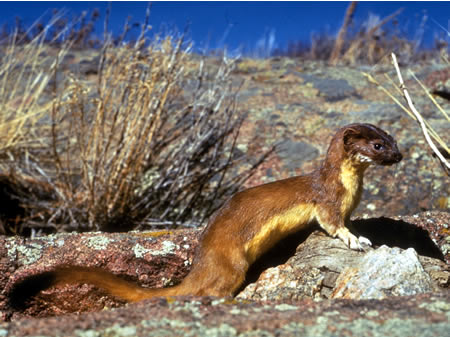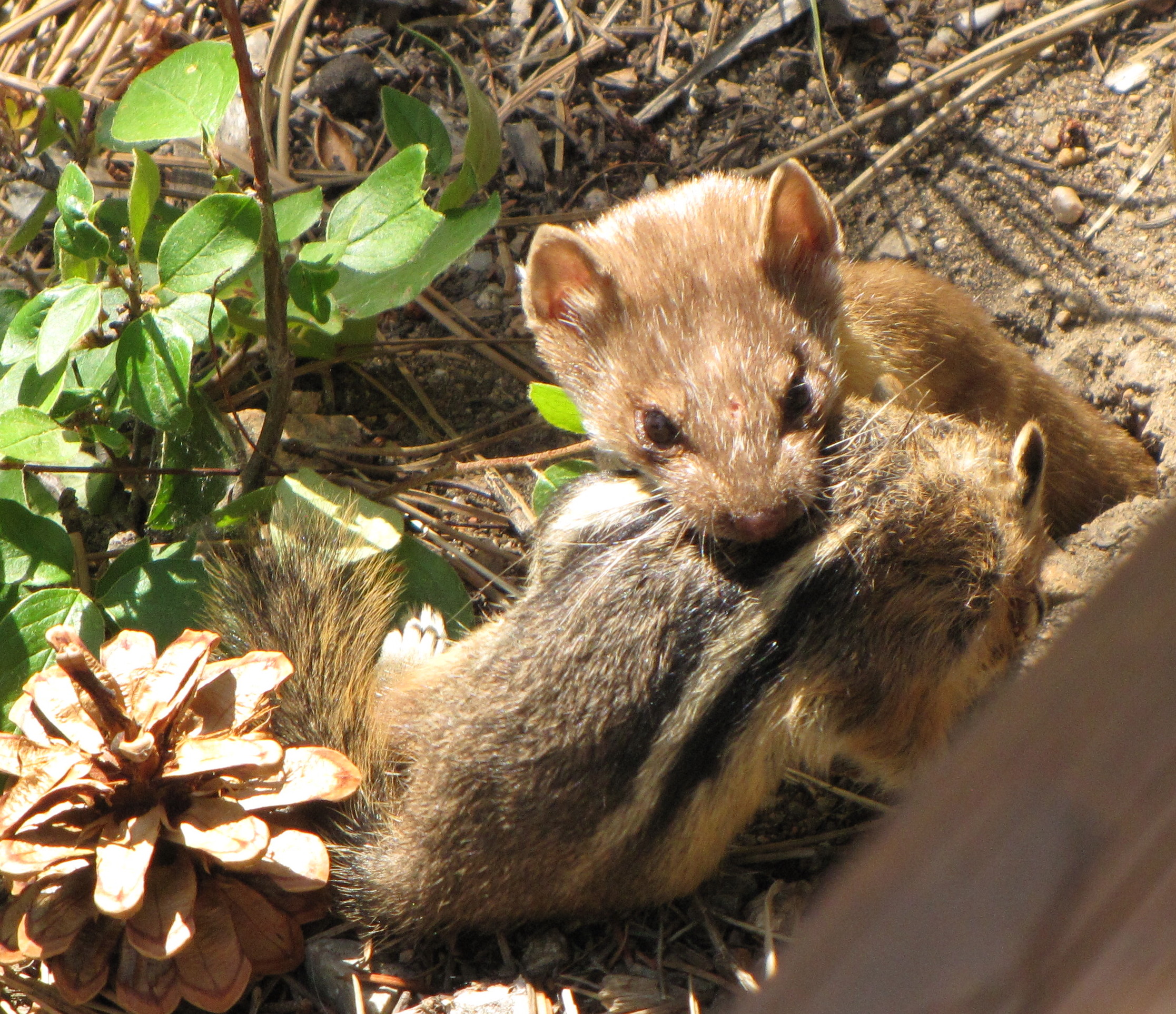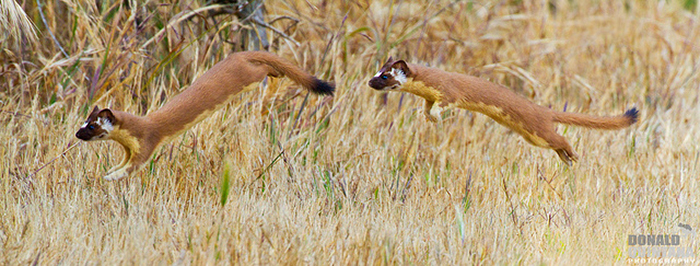Interactions
Mustela frenata has many adapted features to thrive and
interact in its habitat. These weasels are primarily solitary
their entire lives except during the breeding season in which
pairs are temporarily formed for mating (Adirondack Ecological
Center 1988). For more information on mating
click here! Whether to attract or repel other organisms, this
mammal has several means of communications among its species.
Scent and vocalizations play the largest role in the encounters
and organization of other long- tailed weasels (Adirondack
Ecological Center 1988; DesertUSA 2014). Adults may hiss,
screech, purr, or even make a distinctive “took-took-took” sound
to get its point across (Adirondack Ecological Center 1988).
Scent also plays a major role in the communications among
weasels and unwanted guests. During the
breeding season, females
emit an attractive smell to males, notifying that she is ready
to mate (Animal Diversity Web 2002). On the other hand, when
startled or marking, these weasels release the contents of their
larger anal gland which forms an extremely foul odor that is
nauseating to other animals (Adirondack Ecological Center 1988).
Not only does this odor repel
possible threats, but it even
reduces the consistency that they are preyed upon by the same
predator (Adirondack Ecological Center 1988).
Yet so, Mustela frenata must remain elusive to the predators that can handle the smell. Several consumers of these weasels include barred and great- horned owls (Example: Bubo virginianus) , coyotes, marten, and both red (Example: Vulpes vulpes) and gray fox (Adirondack Ecological Center 1988; St. Pierre et al. 2006). To avoid these, long-tailed weasels are extremely quick, alert, and are quality climbers and swimmers (Animal Diversity Web 2002). Not only this, but they usually maintain hidden in “refuge” type areas that are characterized with large amounts of camouflage such as tall grass, woody debris, and rocks (St. Pierre et al. 2006). Habitat information can be found here! Unfortunately, weasels cannot hide from other bloodthirsty organisms such as parasites. Some notable external pests include fleas, lice, and ticks. Other internal parasites include such organism as trematodes and nematodes (Example: Wuchereria bancrofti) (Sheffield and Thomas 1997).
Long-tailed weasels are very efficient carnivores as well. Unlike
other Mustela weasels, Mustela frenata are
slightly larger and longer which may allow for a greater diversity of
prey (St. Pierre et al. 2006)! They
primarily prey upon small rodents and animals such as mice (Example:Mus
musculus), voles (Example:Microtus
californicus) ,
moles, chipmunks, squirrels (Example:Sciurus
carolinesis), rabbits, and other weasels (St. Pierre et al. 2006).
When animals such as these are scarce, weasels may also consume insects
(Example:Melanoplus
devastator) , earthworms (Example:Eisenia
fetida), frogs (Example:Pseudacris
regilla), snakes, eggs, and even birds (Adirondack Ecological
Center 1988). It is required that a weasel eats roughly around twenty to
thirty percent of i ts own weight every twenty- four hours to flourish in
the wilderness (Adirondack Ecological Center 1988). For males, who are
much larger than female weasels, they must consume more and thus tend to
target larger prey such as the rabbits (Gehring and Swihart 2004). Most of their
hunting occurs during the night since weasels are nocturnal, but they
forage during the day as well (Animal Diversity Web 2002). The pattern
to which they hunt is very tedious, yet promising. Using the senses of
smell and sound individual weasels venture for up to 7 miles exploring
every nook and cranny (Adirondack Ecological Center 1988)! After such a
task, Mustela frenata prefers to quickly terminate its next meal. It
kills its prey usually by pouncing onto the animal and with quick bites
in the throat and spinal cord region severs a major blood vessel, thus
fatally wounding the creature (Adirondack Ecological Center 1988). With
its capture, it is characteristic of these animals to store excess food
near its nest for later consumption when it is needed (Adirondack
Ecological Center 1988).Despite their small size, these weasels play a
prominent role in the regulation of the ecosystem and has both positive
and negative impacts in humans. Through their strenuous hunting
explorations, long-tailed weasels help to control populations of many
rodents and rabbits (Animal Diversity Web 2002). Not only this, but
weasels are wonderful mousers for farmers who wish to eliminate small
pests (Animal Diversity Web 2002). The pelts of weasels were also
available during the fur trade, but were not a hot commodity (Animal
Diversity Web 2002). Unfortunately though, they have been notorious to
raid poultry flocks and eliminate many products that people wish to use
(Animal Diversity Web 2002). All in all though, Mustela frenata plays a
positive role in the wilderness.
ts own weight every twenty- four hours to flourish in
the wilderness (Adirondack Ecological Center 1988). For males, who are
much larger than female weasels, they must consume more and thus tend to
target larger prey such as the rabbits (Gehring and Swihart 2004). Most of their
hunting occurs during the night since weasels are nocturnal, but they
forage during the day as well (Animal Diversity Web 2002). The pattern
to which they hunt is very tedious, yet promising. Using the senses of
smell and sound individual weasels venture for up to 7 miles exploring
every nook and cranny (Adirondack Ecological Center 1988)! After such a
task, Mustela frenata prefers to quickly terminate its next meal. It
kills its prey usually by pouncing onto the animal and with quick bites
in the throat and spinal cord region severs a major blood vessel, thus
fatally wounding the creature (Adirondack Ecological Center 1988). With
its capture, it is characteristic of these animals to store excess food
near its nest for later consumption when it is needed (Adirondack
Ecological Center 1988).Despite their small size, these weasels play a
prominent role in the regulation of the ecosystem and has both positive
and negative impacts in humans. Through their strenuous hunting
explorations, long-tailed weasels help to control populations of many
rodents and rabbits (Animal Diversity Web 2002). Not only this, but
weasels are wonderful mousers for farmers who wish to eliminate small
pests (Animal Diversity Web 2002). The pelts of weasels were also
available during the fur trade, but were not a hot commodity (Animal
Diversity Web 2002). Unfortunately though, they have been notorious to
raid poultry flocks and eliminate many products that people wish to use
(Animal Diversity Web 2002). All in all though, Mustela frenata plays a
positive role in the wilderness.
Back to Reproduction Go to Facts
